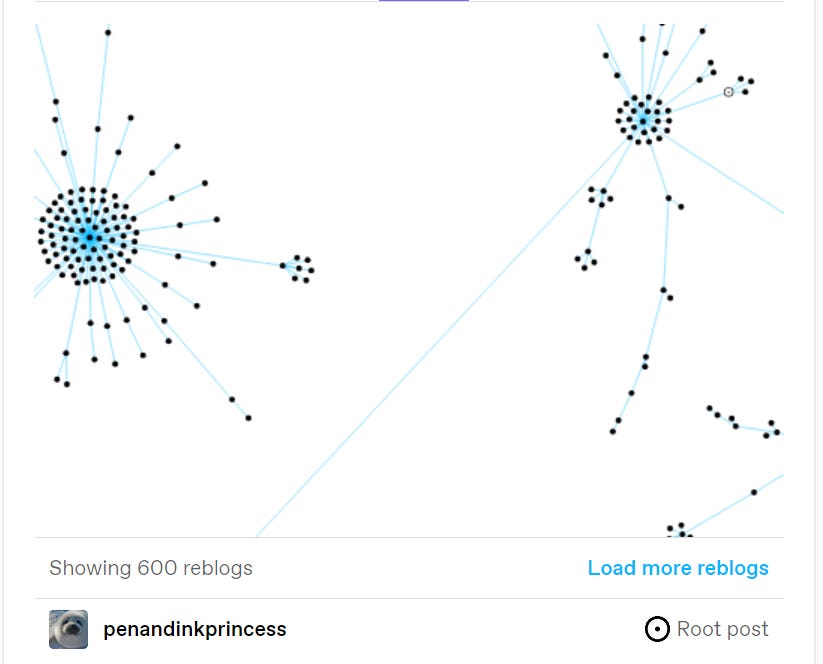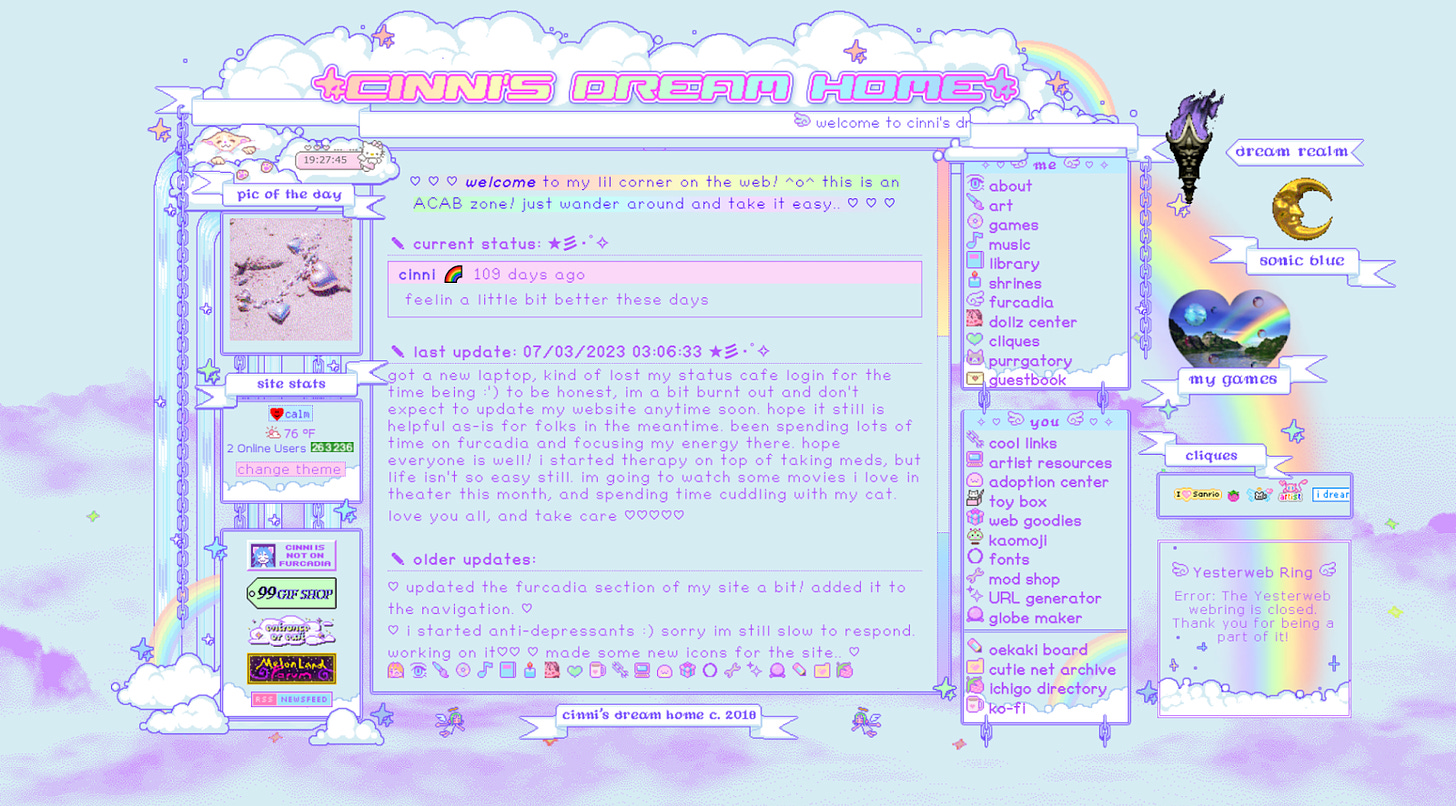Analemma #3: The (Cyber) Fall of the House of Usher
Or; Social Networks and the Internet as a Haunted House
Long time no write! It’s the 12th day of Thermidor, the day of Salicorne (or Common Glasswort, whose name comes from the fact that the ash of the plant is used for the production of glass). Originally, I had only meant to take a quick writing break, but life, as it so often is, intervened. But I’m back, and with a bit of a change from my last few entries, because there’s a topic I’ve been rolling around and trying to write about for a while, and current events finally got me to tackle it. Thanks for sticking around, and I’m excited to be back.
When we lose parts of the internet, we lose parts of ourselves. And I could start this by talking about Twitter, about the way the changes to it are driving a vital digital record further and further into the ground.
But instead, I'm going to start this like I start a lot of posts: by talking about Tumblr. No, I'm not digging into them considering taking on a Wikipedia style user funding, or them considering changing how reblogs work. Those things are both part of the tumultuous landscape of social media at the moment (and the former was already eloquently covered by Ed Zitron). Both of these issues reflect the fact that the internet is shifting under our feet, facing patterns of mass relocation and re-orientation as the fault lines fully reveal themselves across social media networks.
Instead, I'm going to be starting this by talking about a new Tumblr feature.
Recently, Tumblr introduced a feature that lets you look at a social network graph of all of the reblogs of any post. It provides a physical map of the reblogs of posts, showing the way that they flow across the site, revealing who reblogs from who, who holds social power via influencing a post, and the like. A social network (outside of the Aaron Sorkin film) is a way of conceptualizing the social ties between people, with individuals represented as nodes tied together by various edges, which represent ties between people.

It's a fascinating feature because these maps are all about power. For example, the Facebook API used to allow access to the data that would allow users to create their own social network maps. These maps could incidentally reveal vast amounts of information about people's lives: who were the different clusters of people they were friends, who were their relatives, where did they go to school, and so on. However, in 2014, Facebook began to curtail access to this data, stripping more and more access to it, often to the detriment of tools that were designed to help marginalized individuals with the process of networking. In sum, it had begun to keep people from the data that allowed the platform to function in the targeted way that it had become known before.
Another example is the fallout of the Enron Scandal. As part of the discovery in one of the resulting suits, a vast corpus of emails was made publicly available. These emails became invaluable for researchers who wanted to understand the ways that social ties are made manifest through digital communication mediums. Again, being able to navigate and see ties allows an immense amount of power in understanding how people are tied together.
So Tumblr making these graphs public is a fascinating case of allowing users to think about their digital footprint and consider who they are tied for, what other users have control over the popularity of their posts on the site, and so on. It's a manifestation of the power that ties and connections have in our lives. By giving users access to this information, they're being given more control over their space, allowing them to visualize the power and connections that grant the platform life. It's not an advanced argument to say that what makes platforms viable is the actual platform itself— it's the users, the way that they make the platform their own. It's these webs that they build, how the actions of a single user emended in a social network of ties will have ripple effects across the entirety of the platform.
And to be fair, Tumblr is deemed by its userbase to be essentially shooting itself in its own foot at the moment with the new layout that they're rolling out, which is visually reminiscent of sites like Twitter or Reddit, attempting to appease those who are leaving those platforms, in search of greener pastures that aren't constantly on the cusp of setting themselves on fire. Even if, in response to that need, some think that the platform is actively about to do that. But again, it is these complex dynamics, the push and pull of social ties, that make platforms, and as new users rush in, who knows how the nature of that platform will shift. And this shift is also a reminder that even when platforms grant some level of control or access to information, they can also remove it in other ways. Design and information access is almost always a tug of war event, between the platform and those on it.
A problem of social network studies is that it's difficult to operationalize the ties between individuals. How do you convey history in a single line? the shift of relationships? a single catastrophic day that causes a seismic shift in an online space, that makes a popular meme occur? Social networks convey reams of information, but they do not always manage to easily convey the histories that they hold.
On a parallel slope to this is the fact that social media is based on webs, on the accumulation of our lives— when an exodus happens, that life is lost. Social media platforms hold histories of interconnected lives in the textual data and accounts that make the platform the platform. When platforms are smashed to bits as a result of a need for migration, that information is often lost too. The information about social ties, along with the textual information that makes up the space, becomes lost. It's a phenomenon that plagues fandom studies: the loss of old web forums, due to money running out or petty fan dramas; Livejournal's Strikethrough incident, which drove fandom off of the platform and left many accounts rendered into nothing; or the 2018 Tumblr porn ban, which led many to leave the platform for good.
Fandom's experience with these migrations has demonstrated how each time you try to rebuild your social web, part of your ties are lost, part of your inscribed history is razed to nothing. Even if those things can be rediscovered and rebuilt in new forms, the history that they had is lost. Social ties are a thing of power, and the way that platforms can destroy them, even as they provide access to them, is a specific way of enacting violence upon our digital spaces and how access to the ways in which we are interwoven tells a story that can easily be blotted out. The present moment reflects not the webs rotting to bits, but the beams of the house that they are built on crumbling
Something I say a lot is that the internet is a haunted house. The internet stores its dead, holds the history of the lives on it close. But the problem with haunted houses is that even they can be burnt to the ground. And what happens to the ghosts when that house is destroyed? Where can they go, holding all our memories, all of our ties, but into the ether?
The moment we are in feels like a moment in which the foundations of the house are beginning to sag, like the House of Usher, into the earth. As Twitter crumbles, as we feel the fault lines form across social media, as webhosters lose old forums, and our access to the social networks and the history that is contained is lost, more of the ghosts dissipate into nothing, exorcized from our existence.
Each time we lose a slice of the internet, we lose a slice of our own history.
And for some, there is an answer in the form of Neocities. Perhaps it’s not the only answer, but if you take a glance through it, people are using the platform to create their own sites, creating pro-ad blocker popups, or providing guides to creating sites alongside an overview of digital history and archives. And then there is the simple matter of personal sites– sites like cinni’s dream home, one of the most popular Neocities sites, which showcases how to make a personal site and record that still encourages connection and sharing with others. The problem of these sites is that perhaps they do require a greater degree of buy-in and work than has historically been associated with our social media sites. Perhaps they don’t build up the web of ties in the same way that is historically associated with social networking. But considering how dependent on platforms those ties have been, reliant on software to build them, a new way might just be a way to return agency to users.
There are ways to reclaim these social maps, to remake them into things we once again have leverage over, where we are not just products. And as the old forms dissolve and are revealed as untenable, new approaches just might take root.
Thanks for reading, I promise that next week will (probably) not be as much of a tome. I’ll be back to Friday publication for that one. If you have a Neocities site (or you’ve found ones you love!), I’d love to see them and/or talk to you about them! You can find me on almost all social media sites as hedgefruit, or you can reach me via email at camille@butera.org!





Worth remembering Tumblr had the reblog graphs before! They used to also indicate the usernames on each of the reblog points when selected, and were active as an option from 2016 to the 2020 recoding of the dashboard.
The current version is supposed to get the usernames back "soon" but it's been "soon" for nearly a year now, so it's unclear when that'll happen.